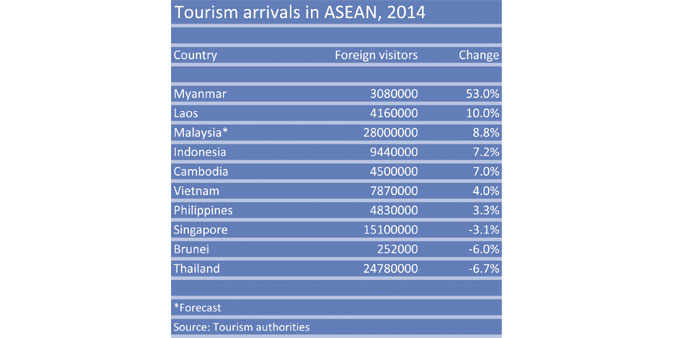By Arno Maierbrugger, Gulf-Times Correspondent/Bangkok
Myanmar took the crown for the steepest growth in tourism arrivals in 2014 within the Association of Southeast Asian Nations (Asean), recording 3.08mn visitor arrivals last year, which is a surge of more than 50% compared to the 2mn visitors in the previous year, according to data from the country’s Ministry of Hotels and Tourism.
Coming in last in the growth comparison was Thailand, which suffered a drop in tourism of 6.7% in 2014 for various reasons, including an unstable political environment and weaker source markets in Europe and Russia. Thailand also saw a drop in hotel occupancy of 11.3% to an average of 65% occupancy, mainly driven by Bangkok hotels, which saw a 16.2% decline in the period.
The big surprise in the list is Laos, the only landlocked country in the region, which welcomed 4.16mn international visitors last year, 10% more than the 3.78mn arrivals recorded in 2013. With this number, Laos already comes close to its neighbour Cambodia and also the Philippines. Furthermore, Laos is already well ahead of its arrivals targets originally set at 3.75mn visitors for 2015, and, interestingly, saw growth in tourists from the Middle East and Africa of 13% to 8,920 last year. The statistics were released shortly before news broke that Laos will be building a completely new tourism complex in the capital Vientiane for $3bn on 300 hectares, comprising of a five-star hotel, a golf course, an artificial lake, an international trade centre, an amusement park and entertainment venues, an international school, a modern hospital and residences for sale designed to reflect the architectural styles of Asean countries. The complex is expected to be finished by 2021, officials said.
Another surprise is Malaysia, whose foreign arrival numbers were “close” to the expected 28mn in 2014, which would account for an 8.8% rise foreign visitors despite the country’s two unfortunate aircraft disasters last year. But as of printing time, official arrival numbers for 2014 have not yet been released by Malaysia’s authorities. While tourist arrivals from China indeed dropped, tourism officials focused their promotional efforts on South Asian countries such as India and Sri Lanka, as well as the Middle East and Europe, said Tourism Malaysia’s Deputy Director General Azizan Noordin.
However, some critics also say that Malaysia’s tourism numbers are pumped up by repeatedly counting day visitors from neighbouring Singapore who would cross the border every other weekend for cheap shopping and cheap gasoline. In fact, Malaysia’s statistics for 2013 show 13.2mn arrivals of Singaporeans — almost half of the total — from a nation that only has a 5.4mn population.
Other countries that benefitted from rising tourism numbers in 2014 were Indonesia and Cambodia and, to a lesser extent, Vietnam and the Philippines, while Singapore, Asean’s third-most visited country and former star performer, experienced a 3.1% drop in arrival numbers, mainly because of retracting numbers of Chinese visitors due to the implementation of China’s new tourism law that set higher standards for Chinese tour operators.
Altogether, the ten Asean countries attracted around 100mn foreign tourists in 2014, and close to 30mn travelled inside the bloc. The upcoming Asean Economic Community and the planned open skies agreement to liberalise air traffic are expected to boost this number further.



